(50 products available)




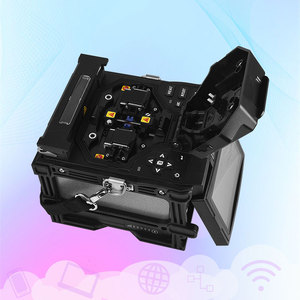












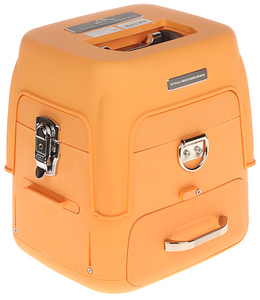
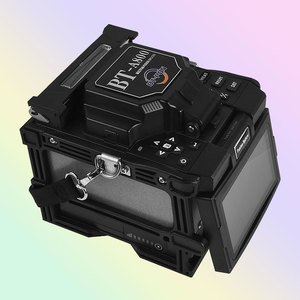




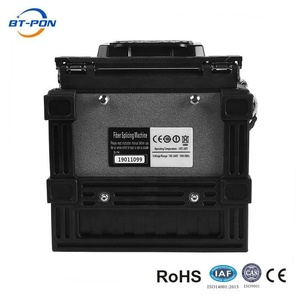






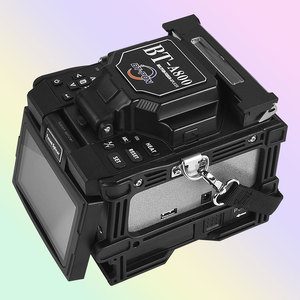













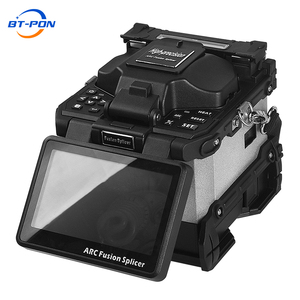



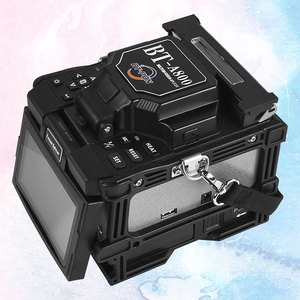





























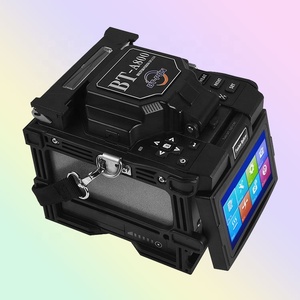














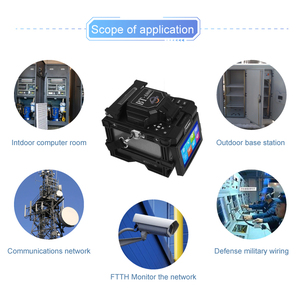

























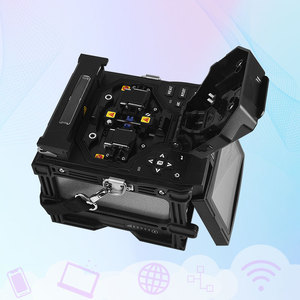






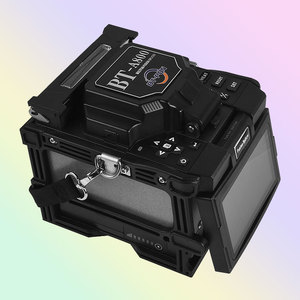






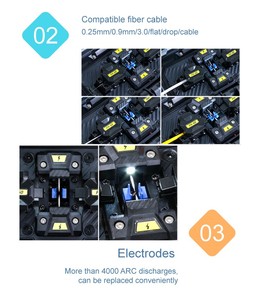





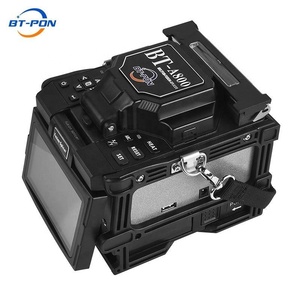


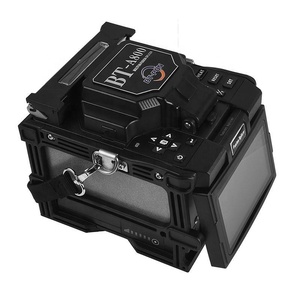
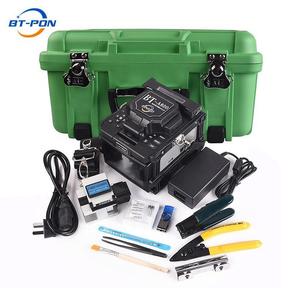










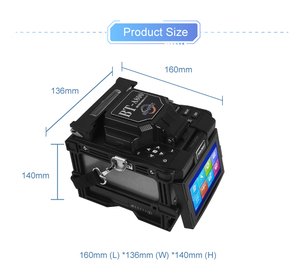



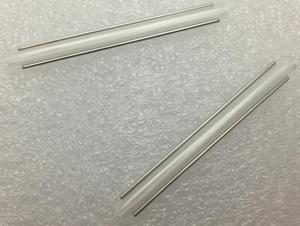


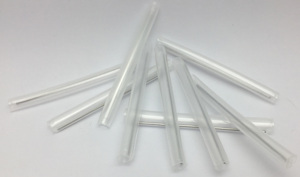






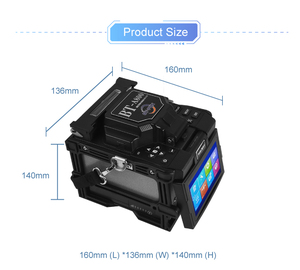






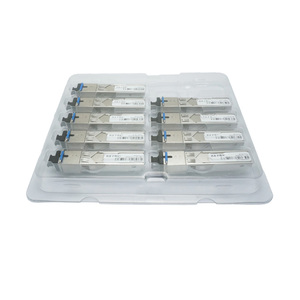




There are several BT fusion splicer types based on parameters such as core count, portability, battery life, and fusion splicing technology. Here are some of the most common:
Single-core fusion splicer
This type of splicer is mainly used for creating fusion splice joints between two fibers. The process cutting the fibers at a 45-degree angle and aligning them will produce a low-loss joint. It is used for making permanent connections in telecommunication networks, where only a few fibers are required to be connected.
Multi-core fusion splicer
Multi-core fusion splicers are designed to splice multiple fiber cores simultaneously. They are important in large-scale installations that involve high-density fiber optic cables. By allowing simultaneous splicing of several fibers, these splicers improve efficiency and reduce connection times in complex networks.
Core alignment fusion splicers
Core-alignment fusion splicers provide precision alignment using a fiber viewing system. They ensure minimal signal loss by precisely aligning the two fiber cores before fusion. They are suitable for splicing single-mode fibers in long-distance networks due to their high accuracy in fiber alignment.
Cladding alignment fusion splicers
Cladding alignment splicers are less precise than core-alignment models but faster and easier to use. They align the outer cladding layers rather than the core, making them ideal for multimode fiber splicing. Their ability to quickly splice larger fiber bundles is useful for installers working on short-distance networks and educational institutions.
Certificate and cold fusion splicers
Cold splicers use an adhesive and a fixture to align and connect fiber without the use of heat. They are portable, more affordable, and require less power, making them suitable for fieldwork. However, they do not provide as strong a joint as fusion splicers, which makes them ideal for temporary or low-traffic connections.
Automated fusion splicers
Automated splicers reduce manual intervention by automating fiber-cleaving and alignment processes. They increase consistency and productivity, especially in installations with large numbers of splices. Automated models are widely employed in infrastructure projects where high efficiency and uniformity are critical.
Hybrid fusion splicers
Hybrid splicers combine fusion splicing with other technologies, like mechanical splicing, to cater to diverse fiber types. Such splicers are adaptable for both single-mode and multimode fibers, offering versatility in various environments. They are beneficial for operators dealing with mixed installations, reducing the necessity for separate splicing equipment.
Here are several factors that business owners may need to consider when choosing a fiber fusion splicer:
Core compensation
Buyers should pay attention to the fusion splicer's core compensation. The splicer should have an automatic core compensation feature, as it helps in the all important accurate alignment of fibers. This, in turn, reduces splice loss and ensures better splicing quality.
Splice loss
Business owners should always look for splicers with low splice loss. Low splice loss will guarantee better connectivity, an important consideration for the end-user.
Splice time and loss
Buyers should consider splicing time and loss. Minimum splicing time will drastically reduce workers’ idle time, allowing them to do other jobs. Furthermore, low splice loss translates to greater connection quality. Both parameters add to the efficiency of the fusion splicer.
Working distance
Buyers should look for splicers with a long working distance. Longer working distances increase the flexibility of the splicer, especially when dealing with different cable sizes. It may also reduce the need for extending fibers.
Heat zone
Users operating in windy or outdoor conditions will benefit from splicers that have wide heat zones. Wider heat zones will effectively mitigate the wind's impact on the splice, resulting in better fusion even under harsh conditions.
Tapering mode
Buyers should consider splicers with multiple tapering modes, as it offers flexibility for various applications. Different tapering modes can be beneficial when users need to splice fibers with distinct thicknesses.
Automatic functions
Business owners should consider fusion splicers with various automatic functions. Automatically working splicing will eliminate manual adjustments, leading to faster and more consistent splices. This can be beneficial in high-volume environments.
Single/ multiple fiber splicing
For businesses that deal with both single and multiple fibers, buyers should look for models that accommodate both. Such fusion splicers will provide flexibility for various projects.
Durability
Buyers should choose fusion splicers that are durable enough to be employed in various conditions. Such splicers will have a protective design for users who operate outdoors or in rugged environments. A durable splicer will reduce the need for frequent repairs or replacements.
Easy-to-follow displays
Many splicers will come with a large screen that provides information on the splicing process; therefore, business owners should opt for splicers with easy-to-follow displays. Good displays help the operators understand the adjustments needed during the process. Also, operators will make fewer errors during the process.
Cable holder
Chemical engineers should choose splicers with robust cable holders. A strong cable holder will keep the fibers in place during the splicing process. It further prevents movement that can lead to poor splice quality.
For the users to achieve the desired results, they must learn how to appropriately use fusion splicers. Here are the steps to guide users on how to use a fusion splicer properly:
Prepare the fibers
Before commencing the splicing process, the user should clean the two fiber optic cables to remove any contaminants that may affect the splicing process. After that, he should strip the fiber of its protective coating by removing about one inch of the outer plastic sheathing. Use a special fiber stripping tool to avoid damaging the glass fiber. Then, using a cleaving tool, make a clean, 45-degree angled cut on both fiber ends. A good cleaving tool is among the most important accessories for fiber optics because it determines the splice quality.
Setting up the fusion splicer
Users should refer to the splicer's manual to operate the machine. The machine should be placed on a stable surface, preferably a wind shield, in case the fusion splicer has a wind shield, especially for outdoor splicers. After that, the splicing program should be selected based on the fiber type (single-mode or multimode) and cable diameter. The inner clamps should be used to securely hold the fibers in place, and the alignment should be visually checked through the optical viewer.
Performing the fusion splicing
Once everything is set, the fusion button should be clicked to allow the machine to automatically align and fuse the fibers together. The splicer will typically take several seconds to complete the fusion process. It is during this time that the two fiber ends are aligned and fused. It is good to note that during this process, the heat protection sleeve should be placed over the splice point to protect the fused area.
Heat the protection sleeve
After the fusion is complete, the splicer will prompt the user to place the heat shrinkable protective sleeve over the splice. It will then use a mini heat gun to shrink the sleeve and ensure proper protection for the joined fibers. Some splicers do have built-in heat for shrunken tubing, so users should check if their machine has it.
Final checks
After the protective sleeve is cooled, users should perform a final check on the splice by monitoring the splicer’s loss values. Any loss above threshold values should be addressed by potentially redoing the splice.
Document the results
Most modern splicers will have data documenting and outputting options, so users shouldn’t forget to document those measurements for future references.
Fiber optic fusion splicers have several benefits that make them more suitable than other fiber optic splicing methods. Here are some of those benefits:
Lower splice loss
A fusion splicer provides a continuous and seamless connection between two fibers. This results in significantly lower splice loss compared to mechanical splicing, where small gaps or misalignments may occur. The lower splice loss means stronger signals and improved transmission quality, especially over long distances.
No alignment issues
With a fusion splicer, fibers are fused using an electric arc, which inherently aligns them perfectly at the core level. This eliminates the potential for human error in alignment, which can lead to increased signal loss or connection failure in mechanical splicing. As such, fusion splicing is particularly advantageous for sensitive single-mode fibers, where precise alignment is crucial for optimal signal transmission.
Semi-automatic operation
Modern fusion splicers automate much of the process, including fiber stripping, cleaving, and alignment. This greatly reduces the skill and labor required to perform a splice. Mechanical splicing often involves more manual steps and specialized skills, which can make the process slower and more prone to error. Minimizing these manual interventions not only speeds up the splicing process but also increases consistency, especially across large installations.
Better for single-mode fibers
Many fusion splicer models are specifically designed to cater to the needs of single-mode fibers. For example, a core alignment splicer can align the tiny cores of single-mode fiber with high precision, while a cladding alignment splicer works well for multimode fiber. Such a specially designed for splicer for single-mode fiber ensures a low splice loss, making it ideal for long-distance telecommunications.
Stronger connections
Fusion splicing creates a more robust and permanent connection between the glass fibers. This typically results in a splice point that has similar strength and durability to the original fibers. On the other hand, mechanical splices use fixtures and can be more susceptible to environmental factors like vibration, temperature fluctuations, or movement.
Improved signal quality over distance
Lower splice loss, minimal alignment issues, and stronger connections all contribute to better signal quality, particularly over long distances. This is especially important in applications like telecommunications networks, where signals need to travel hundreds or thousands of miles without degradation.
A1. A fusion splicer is a device that joins two optical fibers by fusing their glass ends together using an electric arc. The splicer aligns the fibers precisely at their cores to minimize signal loss. By creating a seamless connection, fusion splicing allows for efficient long-distance light transmission in telecommunications and fiber optic networks.
A2. The three main types of fusion splicers are core alignment, cladding alignment, and mechanical splicers. Core alignment splicers use an electric arc to align fibers at their cores for high-precision splicing, ideal for single-mode fibers. Cladding alignment splicers align fibers using their outer cladding layers, suitable for multimode fibers. Mechanical splicers physically hold fibers in place with fixtures, allowing for less precise but more affordable splicing solutions.
A3. Most fusion splicers are designed to handle both single-mode and multimode fibers. However, some specialized models focus on one type, particularly for the core alignment of single-mode fibers, which require more precise alignment. To ensure compatibility, it's important to check the splicer's specifications and the fiber cable diameter the fusion splicer is intended to work with.
A4. Fusion splicers are designed to be portable, though their size and weight vary. Many modern splicers are small, lightweight, and rugged for field use, often featuring a battery for outdoor work. While desktop models are heavier and mainly used in labs, the advancements in compact, durable designs have made most fusion splicers suitable for both field and laboratory splicing.
A5. Fusion splicers can vary significantly, ranging from several hundred to several thousand dollars. Fusion splicers that are designed for fieldwork and have advanced features typically cost more than those intended for laboratory use. In addition to the splicer's cost, the ongoing expense of replacement electrodes and maintenance also must be factored in.